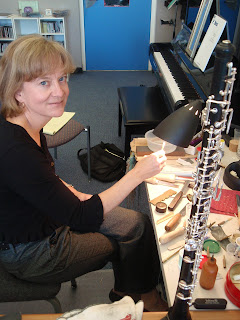Jackie Ball and Vincent Lopez
working on "Balance"
Perched atop a seven foot-tall metal cube, a young woman begins reading from a roll of paper. As she haltingly speaks the words about sale of property and evacuation of premises the paper unfurls toward the floor.
A little later she fall backward out of the box and she is caught by a young man. They make a journey of movement and emotions across the floor of a dance studio.
The two are part of a group of seven dancers making the new piece titled “Balance” for the Wideman/Davis Dance Company.
The piece is about homelessness told sometimes through direct references to home (that box), writings about and by the homeless, and pure movement. It’s the first piece the company has fully created in and about Columbia since Thaddeus Davis and Tanya Wideman-Davis arrived in the spring to teach at the University of South Carolina where their group is in residence.
“Balance” is collaboration between the theater and dance department, psychology faculty researching homelessness and the English department class “Reading and Writing about American Representations of Homelessness.”
“This is about taking part in a larger dialogue about issues and effort to become part of the community as well,” Davis says.
“It’s not all just about pretty dancing,” Wideman-Davis adds.
During recent rehearsals, where much of the dance was still being created, there was a fair share of formally beautiful, if not necessarily pretty, dancing that’s part of the piece set to the music of contemporary composers David Lange and Mark Mellits.
While the title “Balance” can refer to dancing it also speaks to the razor’s edge many people walk to keep a roof above and floor below. A few missed paychecks or an illness is all it takes to send many onto the street.
When Thaddeus Davis and Tanya Wideman-Davis first moved to Columbia they drove down Assembly Street every morning just as people streamed from the Oliver Gospel Mission. Later they noticed the street people of try to remain invisible.
Lopez, Ball and Hannah Langerway
“They just try to blend in,” Davis said. “But you’d see some people sitting and sitting and sitting and three hours later you’d go by and they’d still be sitting.”
One day they kept seeing a couple with a child in a stroller – first here, then there, then somewhere else. They obviously had no place to go.
The couple began teaching a movement class at a shelter for families and one day spied a woman they hadn’t seen at the shelter in a while. She was outside a grocery store with a man who appeared to be bullying her. They discovered it was the time of month when assistance checks arrived. People are able to leave shelters and also liable to suddenly see old friends who didn’t know them when their pockets were empty.
When Davis spoke about the woman outside the grocery, he said he recognized her by the profile of her body and the way she moved.
These sorts of experiences and observations - the facts and the poetry - with which the company intends to imbue “Balance.”
This is similar to the approach Wideman/Davis took in "Based on Images" from earlier this year, dealing with issues surround the emotional and physical toll of Hurricane Katrina, and an earlier dance inspired by the famous quilts of Gee's Bend, Ala., and the women who made them. The couple, who met while with the Dance Theatre of Harlem, founded their group six years ago.
The dancer atop the cube, Jackie Ball, isn’t happy with how she sounds reading the legalese off the long scroll. She thinks she sounds dumb.
“This person has never seen this paper before,” Davis explains to her. “You have to read it inquisitively. This is from an actual document. This is what they send you when they’re gonna take your stuff.”

When Ball, a tiny, muscular student, climbs down from the top of her “house” she and dancer Vincent Lopez head across the floor, confronting and comforting one another, sliding around and ending in a shout, that slips down and starts to disappear.
Like so many of the homeless attempt to do.
Davis, Wideman-Davis,
Lopez and Ball
While “Balance” isn’t meant to bum anyone out (and for those who want to know more, the company will hold an audience feedback session after each show), it will be balanced by a more upbeat work.
“Rock and My Soul” celebrates the spirit of Woodstock, the giant music festival that happened 40 years ago with a bit of exuberance set to the music of Jimi Hendrix, Janis Joplin and Curtis Mayfield.
Prior to the Wideman-Davis performance, USC students will perform pieces by Celia Rowlson-Hall, a New York choreographer best-known for fashion and video choreography; Peter Garick, a South Carolina native, former dancer and manager of the Winnepeg Ballet and director of the Duluth School of Dance; and Hannah Lagerway, a Wideman-Davis company member; along with five student-choreographed pieces.
Wideman/Davis Dance, 8 p.m.
Student showcase, 6 p.m.
Drayton Hall Theatre, Sumter and College streets. Tickets for both are $16. (803) 251-2222.



























































